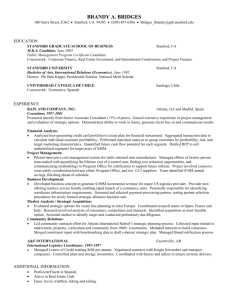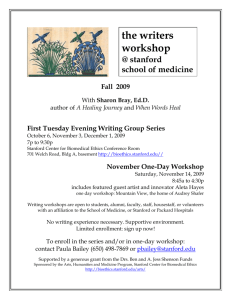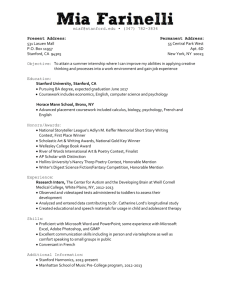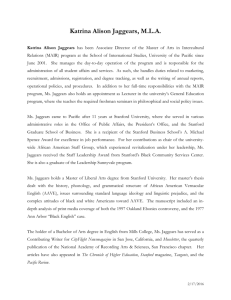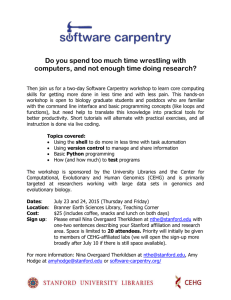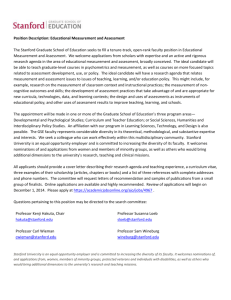Motivation Lit Review
advertisement
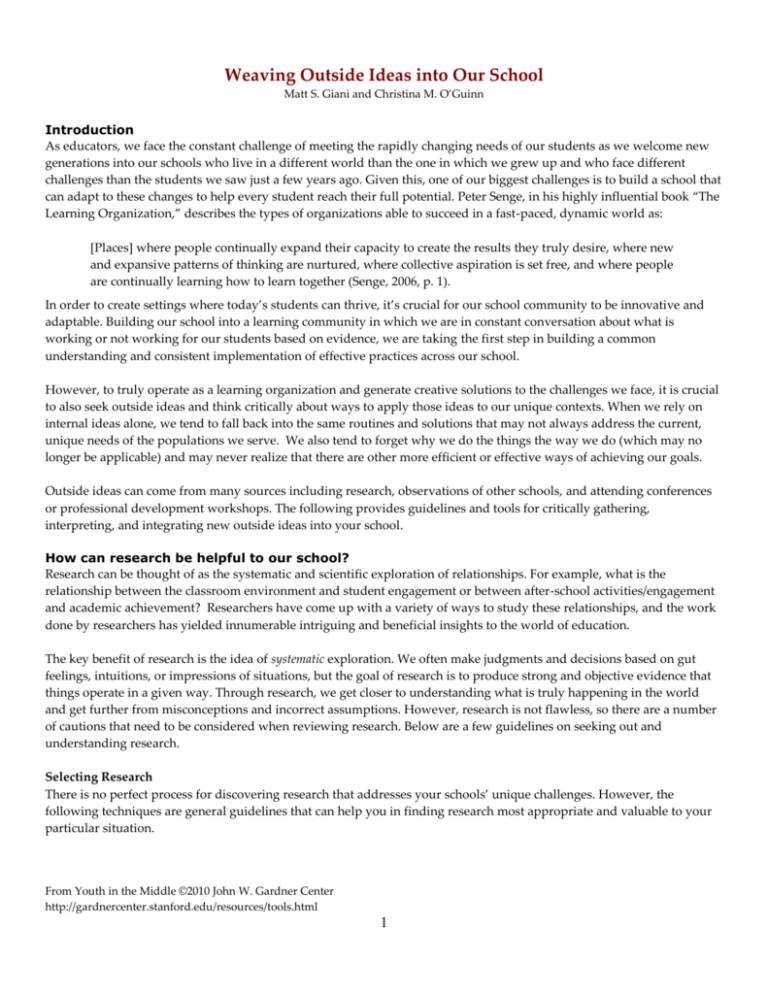
Weaving Outside Ideas into Our School Matt S. Giani and Christina M. O’Guinn Introduction As educators, we face the constant challenge of meeting the rapidly changing needs of our students as we welcome new generations into our schools who live in a different world than the one in which we grew up and who face different challenges than the students we saw just a few years ago. Given this, one of our biggest challenges is to build a school that can adapt to these changes to help every student reach their full potential. Peter Senge, in his highly influential book “The Learning Organization,” describes the types of organizations able to succeed in a fast-paced, dynamic world as: [Places] where people continually expand their capacity to create the results they truly desire, where new and expansive patterns of thinking are nurtured, where collective aspiration is set free, and where people are continually learning how to learn together (Senge, 2006, p. 1). In order to create settings where today’s students can thrive, it’s crucial for our school community to be innovative and adaptable. Building our school into a learning community in which we are in constant conversation about what is working or not working for our students based on evidence, we are taking the first step in building a common understanding and consistent implementation of effective practices across our school. However, to truly operate as a learning organization and generate creative solutions to the challenges we face, it is crucial to also seek outside ideas and think critically about ways to apply those ideas to our unique contexts. When we rely on internal ideas alone, we tend to fall back into the same routines and solutions that may not always address the current, unique needs of the populations we serve. We also tend to forget why we do the things the way we do (which may no longer be applicable) and may never realize that there are other more efficient or effective ways of achieving our goals. Outside ideas can come from many sources including research, observations of other schools, and attending conferences or professional development workshops. The following provides guidelines and tools for critically gathering, interpreting, and integrating new outside ideas into your school. How can research be helpful to our school? Research can be thought of as the systematic and scientific exploration of relationships. For example, what is the relationship between the classroom environment and student engagement or between after-school activities/engagement and academic achievement? Researchers have come up with a variety of ways to study these relationships, and the work done by researchers has yielded innumerable intriguing and beneficial insights to the world of education. The key benefit of research is the idea of systematic exploration. We often make judgments and decisions based on gut feelings, intuitions, or impressions of situations, but the goal of research is to produce strong and objective evidence that things operate in a given way. Through research, we get closer to understanding what is truly happening in the world and get further from misconceptions and incorrect assumptions. However, research is not flawless, so there are a number of cautions that need to be considered when reviewing research. Below are a few guidelines on seeking out and understanding research. Selecting Research There is no perfect process for discovering research that addresses your schools’ unique challenges. However, the following techniques are general guidelines that can help you in finding research most appropriate and valuable to your particular situation. From Youth in the Middle ©2010 John W. Gardner Center http://gardnercenter.stanford.edu/resources/tools.html 1 Research Search Engines: While much research online has to be purchased, there are a number of search engines that connect us with articles that are free to download. The most common are Google Scholar (www.scholar.google.com) and the Educational Resources Information Center or “ERIC” (www.eric.ed.gov). Not all of the articles are free, but after a diligent search you will probably be able to find some free articles relating to your topic of interest. If an article is only available by purchase, you may still be able to glean some ideas from the free abstract/brief summary that can inform your future searches. University Syllabi: Another way to find research that university faculty feel is current and valuable is to look for online syllabi, many of which contain lists of course readings. You can either search for the syllabus in Google by putting in the name of the university, “syllabus,” and the topic of interest to you, or in some instances you can go to the university’s website and find the page that contains all of the syllabi posted by professors. You might seek out university teaching departments, in particular, which will likely include school practice-focused research articles. Key Terms: One difficulty in looking for research is discovering the terminology that researchers are using to describe certain concepts or trends. As in any field, certain words and phrases may have very specific connotations, and it may be difficult to know which terms are relevant to your particular question until you begin to investigate. For example, when searching for research on motivation you will likely stumble across similar research related to engagement, locus of control studies, or self-determination theory, all of which are related to motivation but approach it from different angles. If specific terms come up repeatedly in your search, they may be ideas that are prevailing in the research community. Institutions and Organizations: Sometimes you can turn to specific institutions doing research of interest to you. Most research comes out of three types of institutions: governmental, academic, or non-profit organizations. Some governmental education agencies produce their own research, and others focus more on collecting and summarizing research produced by others. For example, the California Department of Education has a website devoted to research related to youth development. Universities such as Stanford, Columbia University Teachers College, Vanderbilt, and Northwestern often have institutes or centers on campus that produce educational research. Non-profit organizations like EdSource, the Southwest Educational Development Laboratory (SEDL), RAND and SRI produce research as well. The following are links to a few organizations that produce research or research-based publications specifically on youth development: o John W. Gardner Center for Youth and Their Communities at Stanford University: http://jgc.stanford.edu/ o Coalition for Community Schools: http://www.communityschools.org/ o The Harvard Family Research Project: http://www.hfrp.org/ o Chapin Hall: http://www.chapinhall.org/ o Developmental Studies Center: http://www.devstu.org/home.html o WestEd: http://www.wested.org/cs/we/print/docs/we/home.htm o American Youth Policy Forum: http://www.aypf.org o California Department of Education: http://www.cde.ca.gov/ls/yd/ o United States Department of Agriculture: Cooperative State Research, Education and Extension Service: http://www.csrees.usda.gov o The Forum for Youth Investment: http://www.forumforyouthinvestment.org/ Journals: You can also look to specific journals for research. One of the benefits of journals is the fact that they often serve as disseminators of the most recent and creative approaches to education. While governmental agencies often take a more conservative approach and wait for substantial evidence to accumulate before promoting certain ideas, journals seek out research that, by definition, is new and fresh in some way. Some well-known and reputable general education journals include the American Educational Research Journal, the Teachers College Record, and the journal of School Effectiveness and School Improvement. Additionally, journals on specific topics within education also exist, such From Youth in the Middle ©2010 John W. Gardner Center http://gardnercenter.stanford.edu/resources/tools.html 2 as the Journal of Research in Science Teaching and the Research in the Teaching of English journal. For one list of education journals and their rankings based on the number of citations, visit www.edu.salford.ac.uk/her/documents/JournalsWOK.rtf. Assessing Research Once you’ve selected your research, it’s also important to assess the quality and applicability of the studies to your particular question. The following are some additional strategies that may help in the evaluation of research once it has been found: Sample: In almost all research articles, there will be a section that describes the subjects of the research. Was it second grade students in a language arts class? African-American adolescents? Seventh grade algebra students on free-andreduced lunch? While this may seem trivial, the sample is an extremely important element of research because findings generated from research with one group will not necessarily apply to another group. If researchers found that small-group instruction was effective in increasing achievement of high-school students, that does not necessarily mean that it will be effective for middle school students. When looking for ideas about a specific population (seventh grade English-Language Learners, for example), you will want to find research that has been conducted on populations similar in terms of gender, race, socioeconomic status, achievement levels, and other factors. If you cannot find studies that have examined the exact population of interest, you can still look at key findings in other settings and/or with other populations and consider how that might inform your own practice. However, you will want to be aware of population differences and how this could affect the ability to repeat these results. Sample Size: While the individuals in the study affect the ability to generalize to particular populations, the size of the sample affects whether or not the results can be generalized at all. For example, if researchers want to know if the use of new technology in the classroom will facilitate learning in a study conducted with only a few people, it would be difficult to see whether or not the effects are caused by the technology or just happened by chance. With larger samples, the probability of getting a result by chance becomes smaller. However, this issue pertains more to studies with quantitative or numerical data and analysis rather than qualitative research. There is value in understanding what researchers have found in their studies of large populations. There is also value in understanding the nuances of more qualitative studies that often focus on a much smaller number of participants. The large samples remind us of patterns, trends, and the “big picture,” while the smaller (even case study) samples remind us of the complex nuances present in any social phenomenon such as teaching, learning, and human development. As teachers, it is important for us to consult both—the forest and the trees—without getting lost in and/or over-responding to either one. Mediating Variables: Unfortunately, researchers often make conclusions about the relationship between two things without thinking critically of other possible explanations for the findings. For example, researchers conduct a study to assess the effectiveness of a new math curriculum, and they find that students that used the new curriculum performed better than students who used the old curriculum. From this, they conclude that the new curriculum is more effective. But what are some other possible explanations? What if the researchers selected the most qualified teachers to introduce this new curriculum, because they thought it was too challenging for inexperienced teachers? What if the students were told that this new curriculum was “more effective” and the results were nothing more than a placebo effect? Whenever you’re reading research, it is important to consider other possible explanations for the findings in order to prevent false conclusions. Correlation vs. Causation: This point is similar to the previous one, but it is directed more at the language that researchers use to explain their techniques and the warranted conclusions that can be drawn from those techniques. In many studies, in fact most research studies, the researchers will look at the correlation between two variables, such as income and student achievement or race and self-esteem. This correlation is usually indicated by an “r” and some From Youth in the Middle ©2010 John W. Gardner Center http://gardnercenter.stanford.edu/resources/tools.html 3 number between -1 and 1, with -1 indicating a strong negative relationship between the two variables and 1 indicating a strong positive relationship between them. Researchers may in fact discover a relationship between these two variables, but it is important to note that correlation is not causation. For example, parental education level has been shown to be correlated with student achievement, but this does not mean that parental education causes student achievement to increase. What causes the increase in student achievement could be more time spent with the child, more encouragement to excel in academics, higher expectations of the student, or a number of other phenomena. If researchers report a strong correlation between two variables, therefore, it is important to not conclude that one thing is causing the other or vice versa. This is another place where qualitative research can be helpful—revealing what is happening behind these numbers. Statistical Significance vs. Practical Significance: Quite often in research you will come across a term called “statistical significance.” This term refers to a statistical process that helps researchers conclude whether their findings reflect the actual relationship between the variables or whether this relationship happened by chance. For example, let’s imagine that the group of students in the classroom with the new math curriculum scored five points better than the other group of students on the benchmark exam. Could the students have just scored better by chance? A “statistically significant” finding is one where the researchers are quite sure their finding did not happen by chance. Because of this, researchers will often get very excited about statistically significant findings and report them constantly throughout the article. However, just because a finding is statistically significant does not mean that it is practically significant. In the above example, let’s say a new Student Achievement Test (SAT) preparation course results in increased student SAT scores by five points, and the researchers conclude that this is statistically significant. Is it practically significant? If the new SAT preparation course was extremely costly, would it be worth it for an increase of only five points? Even when researchers report statistical significance, it is important to ask yourself whether or not the finding has much practical importance. There is also the case where findings may be statistically insignificant, but because the “subject” is a human being, the finding may not have practical significance. Again, as teachers, we need to be clear about what the research says and what it means for our practice. Replication: One of the most crucial aspects of research is the idea of replication, or doing the study over and over and over again. In any single piece of research, any number of factors could have interfered with the results and caused the researchers to draw false conclusions. This makes it extremely important for studies to be conducted a number of times, and only when the results are found fairly consistently across studies can one conclude that the relationship is really there. Because of this, it is helpful to frame the findings of one study as “suggesting” X rather than “proving” X. This is also why it is important to seek multiple studies or literature reviews that summarize research trends and patterns, particularly when you are using research as a basis for making major school changes. Putting Research into Practice While discovering and analyzing research may be an intellectually stimulating endeavor in and of itself, keep in mind that the end-game of research is to improve practice. Because of this, when reading research it is helpful to always be thinking about what these ideas would look like in practice, and what the effects of these practices might be. Ingenious ideas can be lost in implementation, and as the old saying goes, “The devil is in the details.” There are a few additional strategies that may help you to effectively apply research to practice. First, it is important to have a solid understanding of the research results. Group study can help with this, for although we may be careful and critical, when we read research on our own we, as human beings, automatically translate information in ways that are familiar to us. It is, therefore, very helpful to check our understanding through conversation with others who have read the same research. Indeed, as we build a school community, it is important that we engage in a school-wide dialogue about effective practices based on research and evaluation of our practices so that we can come to a common understanding of the effective practices that work best in our unique contexts with our unique populations. Group study From Youth in the Middle ©2010 John W. Gardner Center http://gardnercenter.stanford.edu/resources/tools.html 4 and discussions will also help you to implement these practices consistently across your school. Some questions that can guide this conversation are: What did you notice in the research that pertains to our question? What evidence supports this finding? How well would this finding apply to our school/population? Do others share this interpretation? Why or why not? Furthermore, as you implement any new policy or practice, it is important to be clear about the goals of this implementation and to have a plan for how you will carry out this practice and assess its effectiveness. An implementation plan includes clear steps for implementing the new practice(s), and it includes a plan for understanding if and how these new practices have the intended impact on student learning and/or experience. Therefore, before implementation of any new practice begins, it is important to identify indicators of progress. What will we see and hear if we are moving in the right direction? When, realistically, would we begin to see these indicators? How will we collect this information? How will we use this information to inform our practice—to help us modify and/or strengthen our implementation plan? How can school observations inform our school? Research is one source of outside ideas. Another possible method of discovering creative and useful thoughts on school improvement is through school or classroom observations. Observers can see exactly how theories and research are put into practice and can even see the effects of those practices in real time. However, just as with research there are some cautions that are important to consider before beginning observations. Below are some guidelines for conducting fruitful observations. Pre-Observation Preparation First, you will want to select a place for your observation. Since you are likely doing this to try to identify practices or policies that you or your school might adapt to your own school environment, you will likely want to select a classroom or school that you believe is doing well in the particular area you are seeking to improve. You might find other schools by talking to community partners who work with other schools, professional education organizations that serve your region, or through contacts at other districts. Observations will often be the most fruitful when you, as observers, come in with specific questions and know what to look for. Observations need to be focused and specific, so the next step is to engage in thorough pre-observation planning that will likely result in informative conclusions. Before any observation, it may help to address the following questions: 1. What is the youth development question we are trying to answer in our small group/whole school? 2. What kinds of practices or policies could we observe in a classroom/school that will help us answer our question? (e.g., behavioral norms, discipline policies, homework policies, instructional practices) 3. What kinds of interactions do we need/want to observe to answer our question? (e.g., teacher-to-teacher, administrator to teacher, teacher to student, student to student, etc.) 4. Which school contexts do we need/want to observe to answer our question? (e.g., classroom, after-school, staff room, school yard, office, etc.) 5. What questions do we have about these contexts/interactions? 6. How will the answers inform our inquiry question? Are all our questions relevant? What do we need to change to better inform our inquiry question? From Youth in the Middle ©2010 John W. Gardner Center http://gardnercenter.stanford.edu/resources/tools.html 5 Observation As you observe, ask yourself what evidence you see of positive youth outcomes, particularly in your target area of youth development. What interactions that you observe between students and staff members align with your vision for your school? What is the general tone of the school? What evidence do you have of this? Then ask yourself what you notice about the practices and policies in each context that might lead to these positive youth outcomes. Are there discipline, homework, or other school policies in place that might contribute? What instructional practices, norms of behavior, or underlying assumptions and beliefs do you notice? You may need to ask specific questions of your host(s) to find out about specific practices and policies you observe. To assist in your observations, we’ve included some observation forms at the end of this document that might assist you during your observation. Post-Observation Debriefing The importance of individual reflection and group debriefing immediately after an observation cannot be overemphasized. No matter how strong your impressions during the observation may be and how confident you are that your observations will stick with you, they will probably begin to fade within twenty-four hours. Individual reflection soon after the observation can help you connect the dots of your observations and develop a deeper understanding of the complex dynamics in the school, but group debriefing can be even more valuable. Everyone goes into an observation with their own personal lenses, so everyone will likely come out with different impressions, interpretations, and ideas about what they just saw. By bringing these different interpretations together, the group compiles a broader and fuller understanding. Below are some guidelines for productive group debriefing. 1. Give each group member five to ten minutes to read over their own observation notes (if they all participated in the observation) or copied notes of those who conducted the observation. As members read over these notes, they can think about sharing: One thing that really stands out or strikes you in terms of evidence of positive youth outcomes particularly as they relate to your small group/whole-school question Two policies or practices that you could see doing in your own context or school that fit with your small group/whole-school question 2. Have each person share these observations while someone charts these ideas, noting where common responses come up with check marks by these items for additional responses. 3. As a group, discuss the following questions, which may help you to further narrow policies or practices that might be particularly useful to your school setting. You may want to use symbols to mark each practice with a characteristic associated with each of the following questions as indicated. Are there any practices that align with other data we’ve collected either at our own school or in the research? (Draw a triangle by practices aligned with other data.) Which practices seem to have the greatest impact on the youth outcomes we want for our students? How can you tell? (Draw a star by practices with greatest impact.) Which practices would be the most practical (because of time/money or other requirements) to implement? (Label the most practical practices with a P.) 4. Decide as a group if there are specific practices/policies that individuals feel they can commit to trying out in their individual contexts before a given timeframe such as the next small group or staff meeting. Alternatively, the group can decide if there is one practice or policy that the entire group wants to begin implementing school-wide. 5. Ask the group to decide how they will assess these practices/policies to determine their effectiveness. From Youth in the Middle ©2010 John W. Gardner Center http://gardnercenter.stanford.edu/resources/tools.html 6 Weaving a Tapestry of Understanding No matter where you go to seek outside ideas, it is important to weave them into your collective understanding of effective practices for your school through constant discussion with your colleagues. Renowned educator and author Parker Palmer defines truth as “an eternal conversation about things that matter, conducted by passion and discipline.” We can only know what is true in terms of effective practices that work in our school settings by engaging in enduring, on-going conversations as a whole-school community with the passion of caring about our students and with discipline of using evidence to support our current understanding of effectiveness. As learners, this understanding is like a tapestry that we weave together. We all contribute new threads of knowledge to the tapestry. We may also remove threads as we gain new insights or understandings, so our tapestry is constantly changing and adapting as we continue to learn and adapt to the needs of our students. From Youth in the Middle ©2010 John W. Gardner Center http://gardnercenter.stanford.edu/resources/tools.html 7 Observation Notes The question we are trying to answer with this observation is:______________________________________________ (Our small group or whole-school question) _____________________________________________________________________________________________________ To help answer this question, it would be helpful to observe: Who: Which school staff members/ interactions What: What kinds of practices or policies do we do we need to observe to answer our question? need to observe that will help us answer our question? What is the Context? (classroom, school yard, etc.) Questions we have about this context? What I wonder… Notes on Positive Youth Outcomes: What I notice… What I hear… From Youth in the Middle ©2010 John W. Gardner Center http://gardnercenter.stanford.edu/resources/tools.html 8 Where: In which school contexts might we observe these interactions, practices and polices? (e.g., classroom, staff room, etc.) Notes on Practices and Policies: What I notice… What I hear… What is the Context? Questions we have about this context? What I wonder… Notes on Positive Youth Outcomes: Notes on Practices and Policies: What I notice… What I hear… What I notice… What I hear… From Youth in the Middle ©2010 John W. Gardner Center http://gardnercenter.stanford.edu/resources/tools.html 9 Observation Notes Example The question we are trying to answer with this observation is: What practices and policies can we use to engage students in school? To help answer this question, it would be helpful to observe: Who: Which school staff members/ What: What kinds of practices or policies do we interactions do we need to observe to answer need to observe that will help us answer our our question? question? - Teachers and students School leaders and students Students and students Observations Context Questions we have about this context? What I wonder… Example: Afterschool program What makes students want to be here? What motivates students to do their homework? - Instructional practices Norms of behavior (particularly between staff and students) Where: In which school contexts might we observe these interactions, practices and polices? (e.g., classroom, staff room, etc.) - Classroom After -school program Notes on Positive Youth Outcomes: Notes on Practices and Policies: What I notice… What I hear… What I notice… What I hear… I notice/hear that… 75% of student population participates in afterschool programs (per CS coordinator) Students seem very happy in their program activities and eager to show us what they are doing/learning Students tease Community School Coordinator affectionately and he reciprocates Students are mostly on task doing their homework, but are distracted by our visit. The teacher jokes with them a bit and then refocuses them on their work. I notice/hear that… The principal took the time to lead this observation Both the principal and community school coordinator know the names and passions of every student we meet and encouraged them to teach us or perform for us The Community School Coordinator said that it is their goal to get every student into an after-school activity to keep them out of gangs, and they work with students individually to match their passions with an activity Students say they come to homework help voluntarily, because they want to do well in school and can get help from teachers there The halls are very clean and have a lot of student work and positive, inspirational sayings on the walls. Hallway From Youth in the Middle ©2010 John W. Gardner Center http://gardnercenter.stanford.edu/resources/tools.html 10 Works Cited Parker, Palmer. “Parker Palmer and The Courage to Teach.” Aurora Forum at Stanford University. Stanford, CA. 21 Feb 2009. Senge, P. M. (2006) The fifth discipline: The art and practice of the learning organization. New York, NY: Bantam Doubleday Dell Publishing Group, Inc. University of Salford. Top education journals by impact factor: ISI Web of Science [data file]. Retrieved from www.edu.salford.ac.uk/her/documents/JournalsWOK.rtf From Youth in the Middle ©2010 John W. Gardner Center http://gardnercenter.stanford.edu/resources/tools.html 11

